Categories
Left column house ads
Cooking Like Andrew Carmellini
October 27, 2011 Restaurant/Bar News
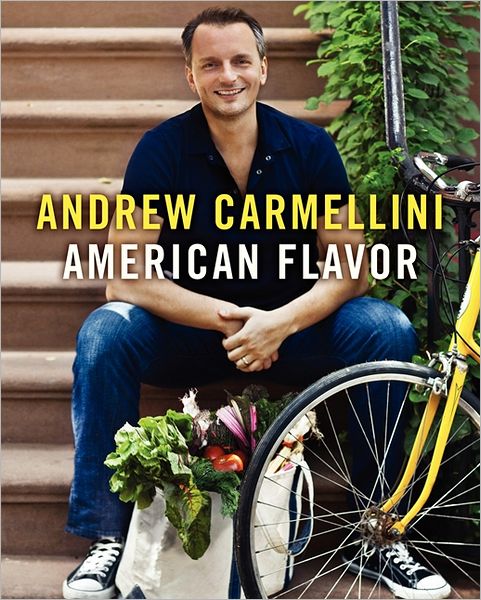 I lay down the law early last week, and it worked: Adam and I were going to cook a meal from Kurt Gutenbrunner’s gorgeous new cookbook, Neue Cuisine, last Saturday night. That morning, however, I spent a half hour browsing it. Everything sounded delicious—no surprise to patrons of Blaue Gans, Wallsé, and Café Sabarsky—but the recipes are rather complex. That doesn’t have to be a problem (in fact, it’s Adam’s preferred way to cook), but I didn’t want to spend a beautiful fall day waiting two hours for something to strain or trying to track down Jerusalem artichokes or lingonberry preserves. I declared that Neue Cuisine was better suited for entertaining, which we’re always resolving to do more of anyway, and that we’d tackle it after Andrew Carmellini’s new cookbook, American Flavor. Carmellini, as you no doubt know, is the chef at Locanda Verde and Soho hotspot the Dutch.
I lay down the law early last week, and it worked: Adam and I were going to cook a meal from Kurt Gutenbrunner’s gorgeous new cookbook, Neue Cuisine, last Saturday night. That morning, however, I spent a half hour browsing it. Everything sounded delicious—no surprise to patrons of Blaue Gans, Wallsé, and Café Sabarsky—but the recipes are rather complex. That doesn’t have to be a problem (in fact, it’s Adam’s preferred way to cook), but I didn’t want to spend a beautiful fall day waiting two hours for something to strain or trying to track down Jerusalem artichokes or lingonberry preserves. I declared that Neue Cuisine was better suited for entertaining, which we’re always resolving to do more of anyway, and that we’d tackle it after Andrew Carmellini’s new cookbook, American Flavor. Carmellini, as you no doubt know, is the chef at Locanda Verde and Soho hotspot the Dutch.
American Flavor celebrates the notion of American food as a cross-pollination, a melting pot. I’m a junkie for the text parts of cookbooks, the introductory material before each recipe that talks about where the inspiration came from, how you might serve the dish, and so on. I will read them over and over and over, as long as they’re good. Carmellini’s book reminded me of Suzanne Goin’s impeccable Sunday Suppers at Lucques in that it brims with anecdotes and joy. I thought pretty much every recipe sounded worth trying, and you never knew what you’d find on the next page. He can get a tad dude-ish (“To make this recipe really rock…”), but I expected that, remembering his last book, Urban Italian.
The Menu
There are a lot of tasty-sounding meat dishes, but we’re mostly vegetarian.
• Coconut-Curry Butternut Squash Soup with Lemongrass and Cilantro Yogurt
• Endive, Apple, and Farmhouse Cheddar Salad with Country Ham and Wheat Beer Dressing
• Rutabaga-Turnip Gratin with Maple Syrup
The Soup
I was destined to like this because I yawn at the prospect of butternut squash soup—every spoonful the exact same as the last. How could it not be better, given that it has lemongrass (which we bought at the Tribeca Greenmarket), curry, ginger, coconut milk, and cilantro. You know how some people can’t stand cilantro? I’m their polar opposite. I huff it while standing in the market. But the main reason we chose it was probably because we had half a kabocha squash from the City Hall Greenmarket, and I was getting sick of roasted squash. We also ended up substituting garam masala for the curry. More on that below.
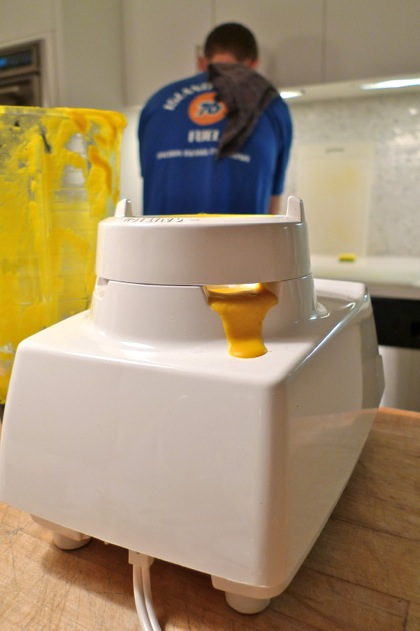 I did some sous chef work, but the soup was mostly Adam’s responsibility, which is why I get to blame him for breaking off the tip of our expensive Korin knife (kabocha victim) and losing our blender’s o-ring seal. We noticed something was wrong when soup began oozing out of the bottom part of the blender. And then there was smoke, but there often is with blenders. On the brighter side, Adam said he would normally be tempted to skip the straining step, but since he thought he might find the knife tip, he did it, and the soup’s texture was really silky. All in all, the soup was definitely a success, although next time we’ll amp up the curry and try and track down dhana dal. As much as it may sound like a Bollywood superstar, Carmellini says dhana dal is “the inside part of the coriander seed, roasted in ghee and salted.” In other words, I want it. Whole Foods didn’t have any, or if it did, I couldn’t find it.
I did some sous chef work, but the soup was mostly Adam’s responsibility, which is why I get to blame him for breaking off the tip of our expensive Korin knife (kabocha victim) and losing our blender’s o-ring seal. We noticed something was wrong when soup began oozing out of the bottom part of the blender. And then there was smoke, but there often is with blenders. On the brighter side, Adam said he would normally be tempted to skip the straining step, but since he thought he might find the knife tip, he did it, and the soup’s texture was really silky. All in all, the soup was definitely a success, although next time we’ll amp up the curry and try and track down dhana dal. As much as it may sound like a Bollywood superstar, Carmellini says dhana dal is “the inside part of the coriander seed, roasted in ghee and salted.” In other words, I want it. Whole Foods didn’t have any, or if it did, I couldn’t find it.
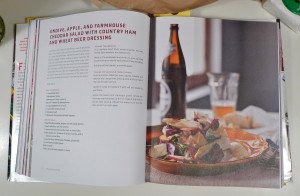 The Salad
The Salad
I had eaten lunch at the Dutch the day before, where I had this salad (ham included), so I figured it’d be interesting to compare our version with the restaurant’s. We skipped the ham this time, and have you ever tried to find a specific beer at Whole Foods? The recipe calls for wheat beer, which I don’t like anyway, and Carmellini recommends Ommegang White from Cooperstown, N.Y. We found a Coopertown ale that Adam said he loved, and it was indeed delicious. Although it was in a big bottle, and it had a fairly high alcohol content, which might explain why I didn’t notice the curry powder in the back of our pantry until it was too late to do much except sprinkle a bit in the soup.
Apples, radicchio, endive, parsley, cheddar—what’s not to like? The dressing, actually. It was not what I remembered from the Dutch. (It may have been entirely different—it’s not described at all on the menu.) It was basically a watery honey-mustard dressing, and it was too sweet for my taste. The beer didn’t make a noticeable impact—perhaps because we used a different one, I grant you—and what struck me as weirdest of all was that the recipe makes more than a cup for six people. I didn’t halve it because I figured I’d use the leftovers later, but even then, I still had an extraordinary amount of dressing left. And the recipe says to drizzle the dressing rather than toss the salad. Am I the only one who thinks that drizzling always feels like you’re eating a takeout salad at your desk? Resolution: Always toss the salad, no matter what the highly acclaimed chef says.
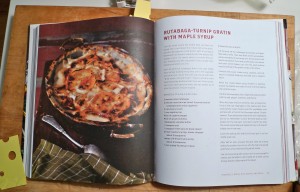 The Gratin
The Gratin
For some reason, whenever I’m in the West Street checkout at Whole Foods, I’m much more likely to try and engage the clerks—probably because there’s no one visibly breathing down my neck. The clerk didn’t recognize the rutabaga—I wouldn’t have, either—so I asked if anyone ever bought rutabagas. “Never!” she said, cackling. Apparently people do buy turnips, which I thought was interesting, but then I work from home and spend too much time with my dog, so who knows.
The recipe was a breeze, as long as you have a mandoline, and it compares very favorably to the many gratins we’ve made over the years. The flavor of the turnips and rutabagas comes through, resulting in a funkier, pepperier gratin than one made with potatoes. It’s a tad sweet, due to the maple syrup, but we may not have minded that too much if the salad had been tangier. I had the rest for dinner the next night, and I was looking forward to it all day.
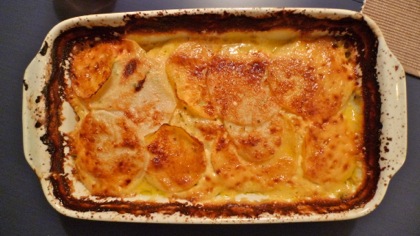 A Few Last Thoughts
A Few Last Thoughts
• The book is actually far quirkier than probably comes across here, with dishes such as Duck with Peaches, Ginger, and Lemon Thyme; Lamb Chili with Chickpeas and Raita; Soup Doria (named after a princess); and Spam Musubi. Browse a copy and you’ll see what I mean.
• Carmellini’s co-author is his wife, Gwen Hyman. How can you not like that?
• It gets a demerit for no prep times (which struck me as especially odd given that the book is at times overly instructive—such as the six steps on how to cut up a squash).
• Food photography is tough and I’m no expert, but it’s really hard when you’re also trying to cook.
• When attempting to cook more than one recipe from the same book simultaneously, make a copy of the recipes so you don’t have to flip back and forth, leading to confusion and accusations of sabotage.
• You can buy it online or at Barnes & Noble, and I’m sure Locanda Verde is selling it. The retail price is $35.
P.S. I just realized we had leftover soup in the fridge and I had it for lunch—it’s fantastic.
1 Comment
Subscribe
Subscribe to the TC Newsletter








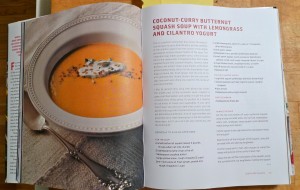
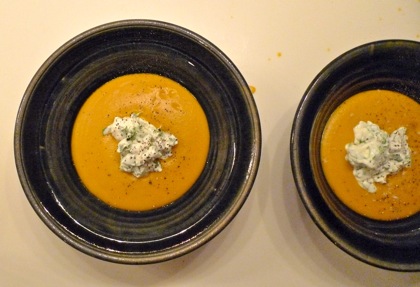
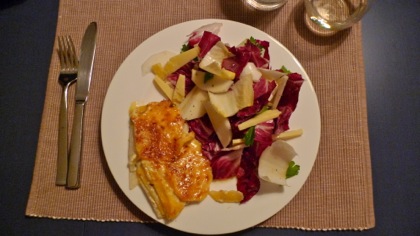











This might be the best post yet on TC. Thoroughly enjoyable, informative, hunger-inducing. More cooking/food/recipe posts please!